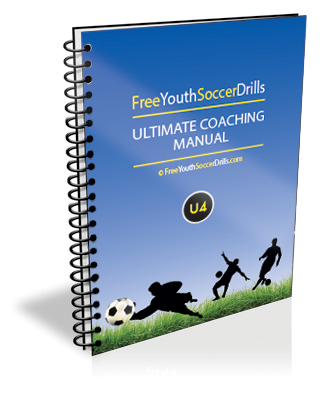Soccer Moves & Turns
This soccer moves page is all about how to learn, coach, and put in to practice all of the popular turns in soccer. Although all of the turns shown below are used in soccer by all age groups, some turns are easier to coach and learn than others. To help you, I have placed a ‘difficulty rating’ below each turn.
Remember, a turn is all about changing direction – if you wish to learn skills or tricks which help beat/get past opposing players then follow the link below.
Skills and Tricks - Soccer Moves!
Drag-Back Turn
(DIFFICULTY RATING: EASY)
The drag-back (or pull-back as it’s sometimes called) is the most simplest of turns and should be coached to players at a young age. I use this turn even with my young U4 players but I pretend its all part of the fun game there playing. For example a player can dribble the ball down to the end, pick up some treasure in a pirate game, do the drag-back turn to face opposite direction and be chased back by the coach.
Th soccer moves turn is very simple to execute.
Step 1 – place your standing foot next to the ball
Step 2 – place your other foot on top of the ball (do not step over the ball and use the heel!)
Step 3 – drag the ball backwards (maintaining control of the ball)
Tip – make sure you turn your body the right way. E.g. if your standing foot is your left foot, your right foot is dragging the ball back, then you want to turn with the ball in a clockwise rotation until your facing the opposite direction.
Even professional players still use this turn from time to time because it’s a shore way of stopping the ball dead if you want to fool the opposing player. They tend to adapt it slightly however by using speed. For example, if you are dribbling at pace with the ball and you have a defender parallel with you whose about to get a challenge in to steal the ball, you can quickly stop the ball dead or roll it slightly behind you by placing one foot on top of it and dragging it back with your foot. Due to the pace you have been running with the defender this will likely fall them and they will carry on running for a moment giving you time and space to dribble in another direction or pass the ball to a team mate.
Outside Hook Turn
(DIFFICULTY RATING: MODERATE)
The outside hook is one of my favourite soccer moves turns because it uses the outside of my foot which I feel comfortable with. Although I have put a moderate difficulty rating some young players will pick this up very easily where as others will struggle to get to grips with using the outside of their foot. We very often use the inside of our foot (passing, shooting etc) but rarely use the outside.
Step 1 – place your standing foot besides the ball (leaving a bit more distance this time between the foot and ball than you did with the drag-back turn.)
Step 2 – your non-standing foot will pass between the gap of the foot and ball. Young players can stand this foot down just past the ball; older players will be expected to incorporate steps 2 and 3 together.
Step 3 – twist your standing foot so the outside of the foot is parallel with the ball (right foot would be 2 o’clock, left foot would be facing 10 o’clock.)
Step 4 - using the outside of the foot, hook the ball in the opposite direction than your currently facing whilst keeping control
Step 5 – turn your body in the same direction as the ball and face the opposite way.
Tip – it helps to have a low centre of gravity with knees bent and arms out whilst doing this soccer moves turn.
Inside Hook Turn
(DIFFICULTY RATING: MODERATE)
This turn can feel a little awkward to do at first and is really more of a flick than a turn once done quickly. It is basically the opposite turn to the outside hook which allows the player to turn the opposite way.
Step 1 – place your standing foot directly behind the ball (lean forward and stay low)
Step 2 – your non-standing foot needs to come round and make contact with the back of the ball
Step 3 – using the inside of your foot, hook the ball behind you
Step 4 – turn (or pivot) in the same direction as the ball so you’re facing opposite direction.
TIP – this soccer moves turn is much easier to do at speed and if your ‘on-your-toes’ i.e. not flat footed.
Stepover Hook Turn
(DIFFICULTY RATING: MODERATE-HARD)
I really enjoy using this soccer moves turn when I’m playing on the wing, but it doesn’t always work and can make you look silly if the opposition player catches you out.
The idea of the turn (when done at pace) is to pretend you are going to pass the ball one way, but instead your foot passes over the ball, and pushes the ball in the opposite direction.
*To make this turn easier to explain, I am going to do the steps as if I was a right footed player*
Step 1 – you must ideally have your back to an opponent (or side on in some cases). Very difficult to perform this turn whilst face-on.
Step 2 – standing foot (left foot) needs to be positioned next to the ball as if you are going to make a pass to your left
Step 3 – your non-standing foot (right foot) will move over the ball (ideally at pace) and pretend that the pass is going to be made
Step 4 – your right foot instead, using the outside of the foot will hook the ball in the opposite direction to the fake pass
Step 5 – follow your ball and hopefully the defender will be briefly following the fake pass allowing you to get away
Tip – in a game situation this soccer moves turn must be completed at pace otherwise the defender will have too much time to see what you are going to do. To make the fake pass realistic, call a name or place an arm out in the direction of the fake pass before pushing off in other direction.
Cruyff Turn
(DIFFICULTY RATING: MODERATE-HARD)
The Cruyff turn (named after Johan Cruyff – former Dutch soccer player) is a stylish soccer moves turn which was used frequently in games by Cruyff. This turn is used often in the modern game due it being a moderately easy turn to master and allows the player to change direction quickly.
Step 1 – place your standing foot next to the ball (but not too close) with your body leaning over the ball
Step 2 – your non-standing foot needs to step over the ball without touching the ground
Step 3 – using the inside of your foot, push the ball backwards
Step 4 – this time (unlike the drag-back turn) your body will turn round the other way (toward standing foot) so you are facing the opposite direction
Tip – once again, this soccer moves turn becomes easier when done at speed and it is important you have good balance.
To see some more soccer moves, click here!




